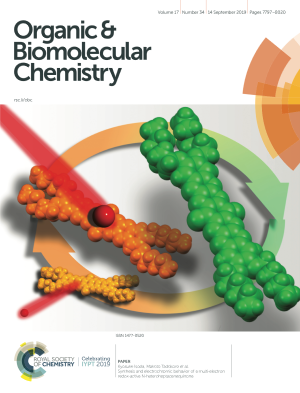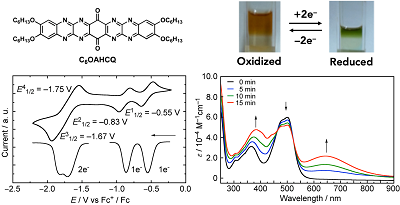磯田恭佑講師らの研究がRoyal Society of Chemistry Publishing社の電子ジャーナル”Organic & Biomolecular Chemistry”のFront CoverおよびOBC HOT article collectionに選出されました。
2019年7月3日に、Royal Society of Chemistry Publishingより刊行された”Organic & Biomolecular Chemistry”誌に、磯田恭佑(創造工学部創造工学科先端マテリアル科学コース 講師)および田所誠教授(東京理科大学理学部化学科)らの研究論文が掲載され、本誌のFront CoverおよびOBC HOT article collectionに選出されました(図1)。
題名:Synthesis and electrochromic behavior of a multi-electron redox-active N-heteroheptacenequinone
著者:Kyosuke Isoda,* Mitsuru Matsuzaka, Tomoaki Sugaya, Takeshi Yasuda, Makoto Tadokoro*
雑誌名:Organic & Biomolecular Chemistry, 2019, 17, 7884–7890.

図1. 採択されたFront Cover
磯田講師および田所教授らは、電解質溶液中で電位を印加することで、その色が橙色から緑色へと変化するエレクトロクロミズム特性を示す分子を新たに発見しました(図2)。
本分子は、N-heteroaceneに対してhydroquinone部位を導入したN-heteroheptacenequinone構造を有します(図2左上)。本分子の溶解した電解質溶液は、電気化学測定により4電子を受容できる有機分子として機能します(図2左下)。測定電位だけを比較すると、電子受容体の代表的なフラーレンC60に匹敵(C60は最大で6電子受容が可能)する電子受容能を確認できました。さらに、この電子受容過程において、紫外可視吸収スペクトルが変化することが分かりました(図2右下)。特に、1電子受容過程においては、その溶液の色が橙色から緑色へと変化するエレクトロクロミズム特性を示すことがわかりました(図2右上)。また、これらの色の変化は可逆的であることも明らかになりました。本分子は、TPOに合わせて窓などの外光の遮光率を制御するスマートウィンドウなどに応用が期待されます。

図2. 分子構造、各種測定結果およびエレクトロクロミズム特性を示す写真
The research paper by Dr. Isoda and Prof. Tadokoro (Tokyo University of Science) was highlighted as Front Cover and OBC HOT article collection in “Organic & Biomolecular Chemistry” (Royal Society of Chemistry Publishing) !!
Title:Synthesis and electrochromic behavior of a multi-electron redox-active N-heteroheptacenequinone
Authors:Kyosuke Isoda,* Mitsuru Matsuzaka, Tomoaki Sugaya,TakeshiYasuda,MakotoTadokoro
*Article:Organic & Biomolecular Chemistry, 2019, 17, 7884–7890.
Abstract: We synthesised a novel electron-accepting N-heteroheptacenequinone OAHCQ derivative as a large π-conjugated framework. The OAHCQ derivative was composed of eight electron-deficient imino-N atoms and an electron-accepting benzoquinone. The OAHCQ derivative exhibited reversible four-step, four-electron reduction waves in its CV trace. The number of electrons accepted by C6OAHCQ in the 0 to −2.20 V window is more than that accepted by electron-accepting fullerene C60. In addition, the OAHCQ derivative shows electrochromism at negative voltages. Moreover, the HOMO and LUMO energy levels (EHOMO and ELUMO) of C6OAHCQ can be approximately determined from the E11/2 potentials in its cyclic voltammogram and the absorption edge of its UV-vis spectrum. The ELUMO of C6OAHCQ, at −4.29 eV, is comparable to that of the well-known methyl [6,6]-phenyl-C61-butyrate electron acceptor (PCBM, −3.8 eV), which is expected to function as an n-type semiconductor. The introduction of tetraaza units and the electron-withdrawing benzoquinone is a novel strategy for the design of high-electron-affinity molecules.
■URL for Paper↓
https://pubs.rsc.org/en/content/articlelanding/2019/ob/c9ob01323g#!divAbstract
■URL for Isoda Lab.↓
https://sites.google.com/site/isodalaboratory/



